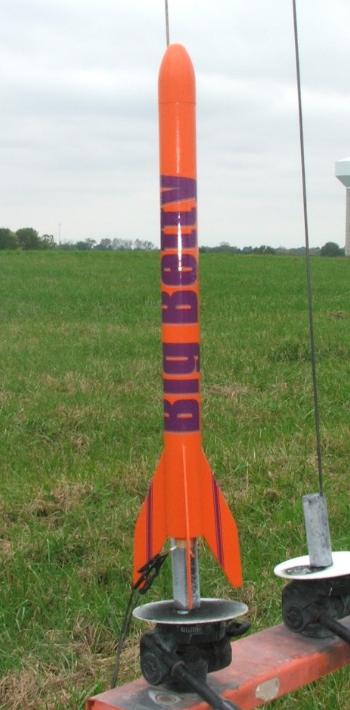| Construction Rating: | starstarstarstarstar_border |
| Flight Rating: | starstarstarstarstar |
| Overall Rating: | starstarstarstarstar_border |
| Diameter: | 1.58 inches |
| Length: | 23.00 inches |
| Manufacturer: | Quest  |
| Skill Level: | 1 |
| Style: | Sport |
Brief:
While nearly identical to the Estes Big Bertha, the Quest Big Betty has still managed to carve out a niche in the entry level market with her upgraded recovery system and lower price. While she is a pretty close copy, she does feature three fins instead of the Bertha's four, making construction marginally simpler while keeping performance right in line with her sister kit.
Construction:
The parts list:
- 18" body tube
- plastic nose cone
- motor mount tube
- engine clip
- thrust ring
- 2 centering rings
- die cut fin sheet
- 2" launch lug
- 24" elastic shock cord
- 24" Kevlar shock cord
- 14" parachute
- decal
Like her fraternal twin, the Estes Big Bertha, the Big Betty is an almost completely agreeable skill level one kit. Construction is as basic as it gets and possibly even easier since the large size of the rocket allows easier access to both internal and external parts. The only thing about the construction process that vaguely resembles a "gotcha" is the loose fit of the nose cone, easily countered with a bit of masking tape. I chose the quick route on this project, affixing the fins first with LocTite Gel CA, then more securely anchoring them into place with heavy glue fillets using Elmer's Wood Glue. I also used wood glue in attaching the motor mount and recovery system. (Speaking of the recovery system, I continue to laud Quest for including a length of Kevlar as a part of the shock cord anchor.) Construction was finished with the addition of a medium snap swivel to attach the nose cone to the shock cord, something I did on all of the kits in this comparison except for the Tangent, which had its recovery system fully functional right from the box.
Finishing:
I also went the simple route on finishing for the Big Betty. Tube spirals and balsa grain were eliminated with a couple of coats of thinned Elmer's Fill 'n' Finish and a brisk sanding. The rocket was then sprayed with Valspar white primer, which was allowed to dry overnight. The rocket was then sprayed with two coats of Valspar Harvest Orange, (only because I happened to be out of Valspar Bumblebee gloss.) The large, simple sticker decals were then affixed (horrid things), and the whole rocket sprayed with a coat of clear acrylic. Despite the ugly decals, Big Betty turned out to be a pretty decent looking girl.
Construction Rating: 4 out of 5
Flight:
For purposes of this comparison, I decided to fly each of the rockets on a C6-5, a B6-4, and a B4-2. The Big Betty is most clearly at home with the C6-5, posting a high, arcing flight that wouldn't be out of place on a small field if you were flying on a windless day. As it was, I wasn't and Betty took me on a merry chase across the field, finally allowing me to catch her on a neighboring soccer field. Impressive flight, but the stock 14" parachute could be reefed without worry.
The B6-4 flight wasn't nearly as high, but followed almost the exact flight path as the wind caused the rocket to cock away from the pad. This time the recovery walk wasn't quite as bad, but my legs aren't what they used to be. I was really looking forward to the B4-2 round of flights.
On a B4-2, the Big Betty flew exactly like the other three rockets in the comparison. The B4-2 barely seemed to be enough to get her off the pad, and her near stop and sudden kick to the right almost made it seem like she was posing for me so I could get the best possible launch shot. I still missed it.
Recovery:
The 14" chute is a pretty good fit for a rocket of this size, but the gripper tabs, while not a problem on a kit with a body tube the size of the Big Betty, are going to be difficult to work with on smaller models. As it is, the stock chute does its job quite well and could even be reefed without surrendering any of its ability to bring the rocket down safely.
Flight Rating: 5 out of 5
Summary:
PROs: Easy to build. Kevlar shock cord included. Reliable small field performance. Price.
CONs: Ill fitting nose cone. Sticker decals are unimaginative and way too thick.
Overall Rating: 4 out of 5
Other Reviews
- Quest Big Betty By Clive Davis
Background: This spring I ran a build session for faculty kids at the school where I teach. I ended up using the Quest Bright Hawk for the 7-9 year olds and the Quest Big Betty for the 10-12 year olds. After the build session, I began thinking about the types of rockets that would make great first builds for a budding rocketeer. I wanted to select rockets to compare that had the ...
- Quest Big Betty By Dan Priven
Big Betty is a fairly large 3FNC model rocket, using B and C motors. It is straightforward to construct and a snap to prepare for flight. With its enormous fins and blunt, rounded nose cone, Big Betty has a peculiar look. It looks either dated or classic, depending on whether you're a BAR or not. Estes' Big Bertha, Big Betty's obvious inspiration, is about 35 years old. For the Freudians among ...
 |
 |
Flights
 |
 |
K.R.J. (September 1, 2001)
J.D.R. (May 12, 2003)
B. B. (June 8, 2003)
P.A. (October 21, 2003)
R.F. (May 25, 2005)
Sponsored Ads
 |
 |













D.K. (August 1, 2000)